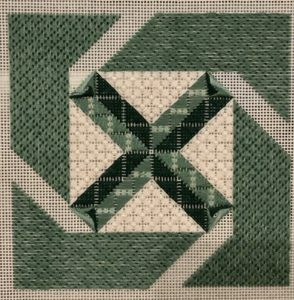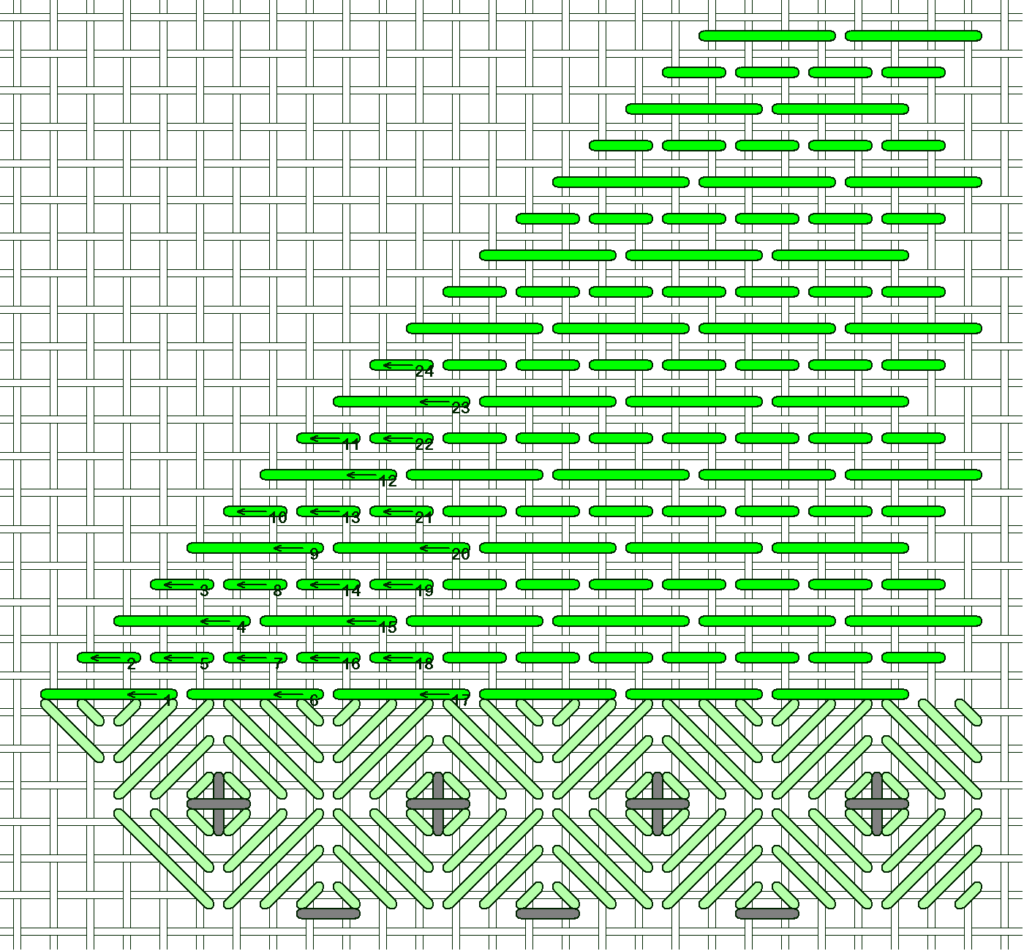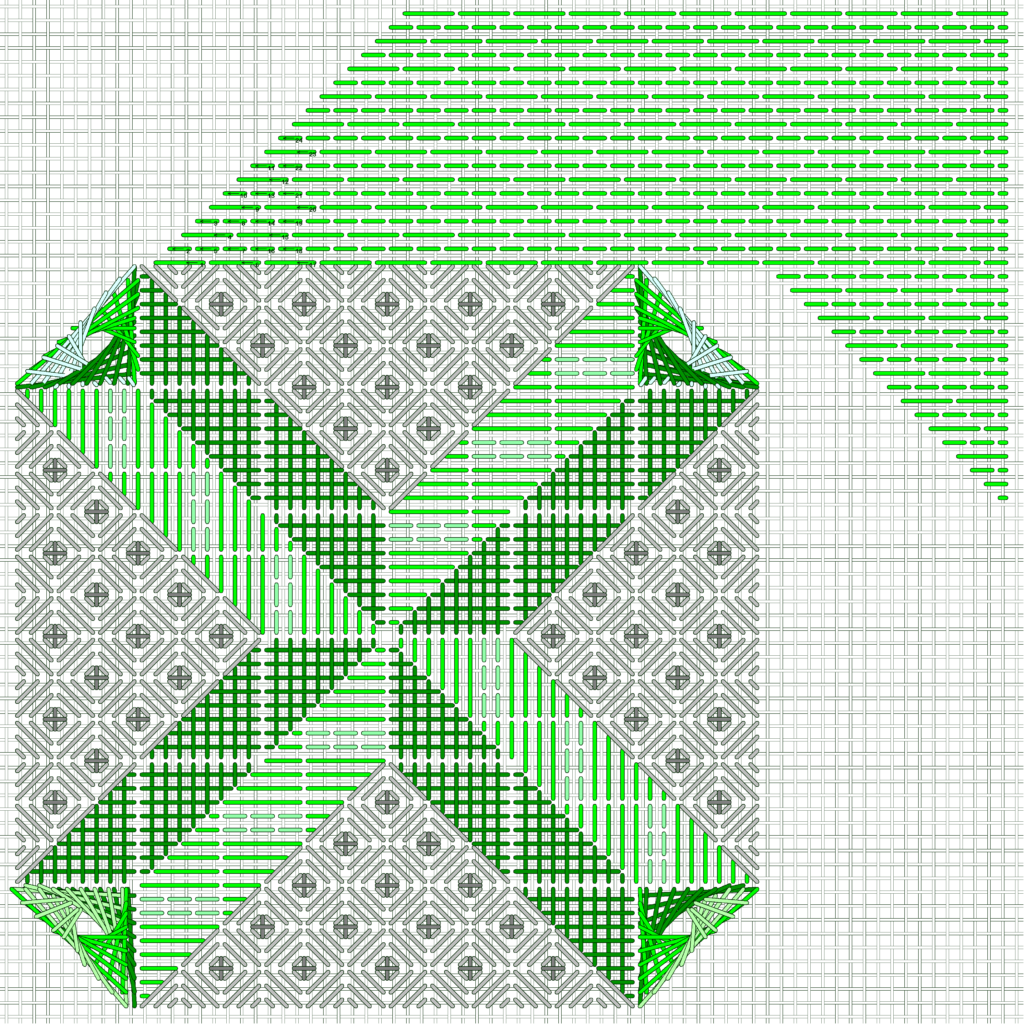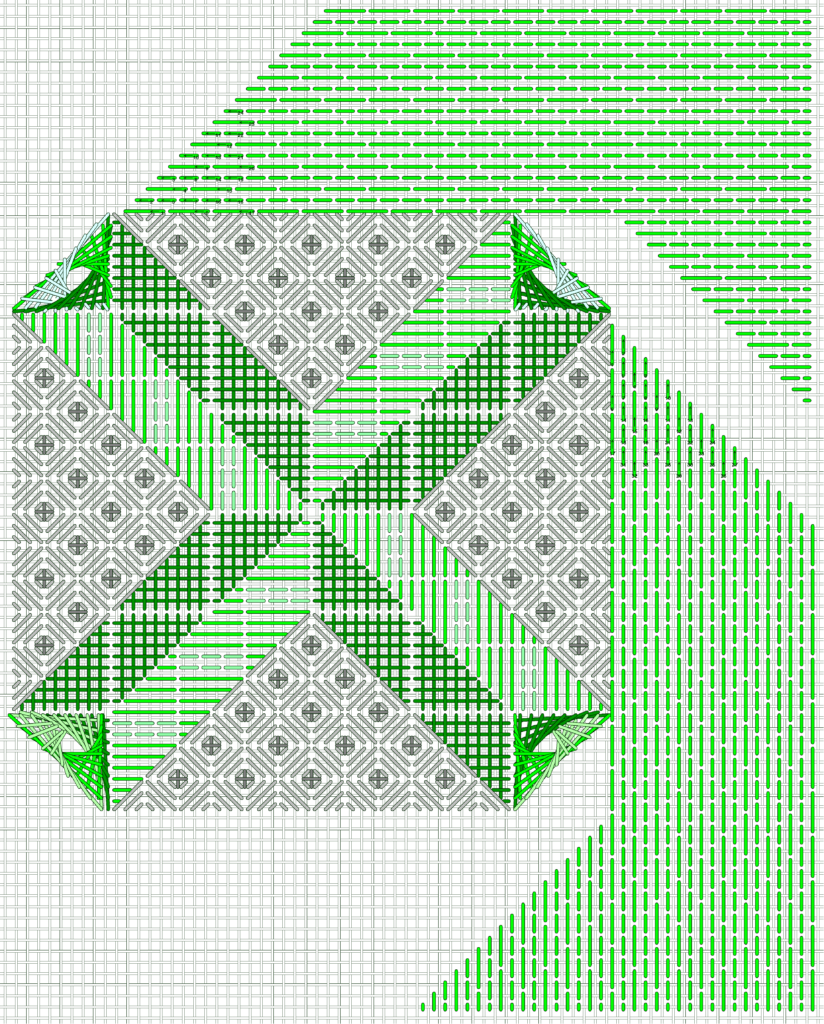
Click here for Labyrinth Section 5 instructions
It’s Monday and time for the next step in our stitch along. Today we’re using Hungarian stitches to cover a lot of territory in the project. And, I’ll include some info about a potential thread emergency while stitching this project – we’ve all had them, so how do you handle them?

There are two types of Hungarian stitches in this project, but both are stitched the same way – “short, long, short, skip”. This is the pattern for all Hungarian stitches. The short stitches are over 2 canvas threads, the long stitches are over 4 canvas threads and sandwiched between two short stitches, and the skip is to allow the long stitch from the next row .
This stitch makes a pretty pronounced diamond pattern, albeit small, which is quite pretty. It’s a satin stitch pattern, so care must be taken to lay the stitches as smoothly as possible.
As you can see from my picture, if you look closely, I was stitching this in a hurry and didn’t lay the stitches. If I had more time, I would have, because I love the look of properly laid satin stitches.

This is the entire first area. Note the compensation at the edges – compensation is just partial stitches in the pattern.
Also, if you look closely at the diagram, you’ll see that all of the long stitches are in horizontal rows with long stitches, and all of the short stitches are in horizontal rows with short stitches. If you wind up with a long stitch in a short stitch row, or a short stitch in a long stitch row, you’ll probably need to take those stitches out and try again.

The next area is also Hungarian stitch, but vertical this time. The pattern is the same – short, long, short, skip – with compensation at the edges.

Continue stitching Hungarian stitches, using the same thread, for the other two areas to complete this portion of the project.

You’ll notice I haven’t said which thread to use yet. For these areas I used the same thread, Spendor S906 Medium Pistachio, 4 strands. And this caused a slight moment of panic – I wasn’t sure I’d have enough to complete the areas. So here’s how to handle a potential thread emergency/crisis.
First, I checked to see if I had another card – no such luck. Since I don’t have a shop anywhere close to me, I had to think through options. This is the process, in case you find yourself in a similar situation.
Bear in mind that the stitches reflect light differently, whether it’s vertical stitch or a horizontal stitch. In this case, I have 2 areas of vertical stitches and 2 areas of horizontal stitches; the thread is going to look like a different color in any case because of this.
My Splendor is of unknown vintage, probably acquired 15 to 20 years ago. Dye lots change, sometimes a lot, over the course of time. I had no guarantee at all that even if I ordered another card, it would more than likely not match what I already had. I had too much stitched in to even contemplate taking it out and starting over again. So that meant shopping in my stash to see if I had anything at all close.

The existing card of Splendor, and what I had left to stitch the fourth area, is shown in the center. Since I was using 4 strands I wasn’t sure that would be enough. I compared the thread to what I had at home, starting with a different silk, Treenway 953. Treenway Silk Harmony is 6 strand, and Splendor is 12 strand, but I thought I could probably get similar coverage with 3 strands instead of 4. The Presencia and DMC threads are 6 strand cotton floss; I thought the Presencia was a tad too green, not the blue-ish green of the Splendor, so I ruled that out. I wasn’t completely happy with the DMC threads either, but thought about using 2 strands of the 163 and 2 strands of the other one (can’t see the number and I’ve since put it away); blending colors can sometimes arrive at the desired shade.
In the end, I thought the Treenway Silk Harmony would be the best option, should it be required. And, I got lucky – I didn’t need it and had enough of the S906 to stitch all four sections. But I thought the process of arriving at a substitute, and the reasons for it (light reflecting differently, slim chance of matching dye lots), might be of interest should you find yourself in a similar situation.
Next week, no more S906, but we’ll be moving on to the next step.
3 thoughts on “Let’s cover a lot of ground with Hungarian stitches”
Hi Debbee, I have worked on Labyrinth and have finally finished this step (5). Will you be continuing in the new year or should I figure out some stitches on my own to finish it up?
Hi Jean, due to the response I received I decided not to complete the project on my website. I did finish it for myself, but don’t think I’ll finish it; it’s living in a drawer. I used a scotch stitch over 3 canvas threads to complete the outer edge, then crossed on corner of every other block with a matching metallic braid. Finally I used the darkest green to backstitch over the hungarian diamonds to fill in the diamond shape. I hope this helps! Thanks, Debbie
I tried to email you the picture but the email address bounced, if you’ll email me at Debbie@DebBeesDesigns.com I’ll send you the picture.